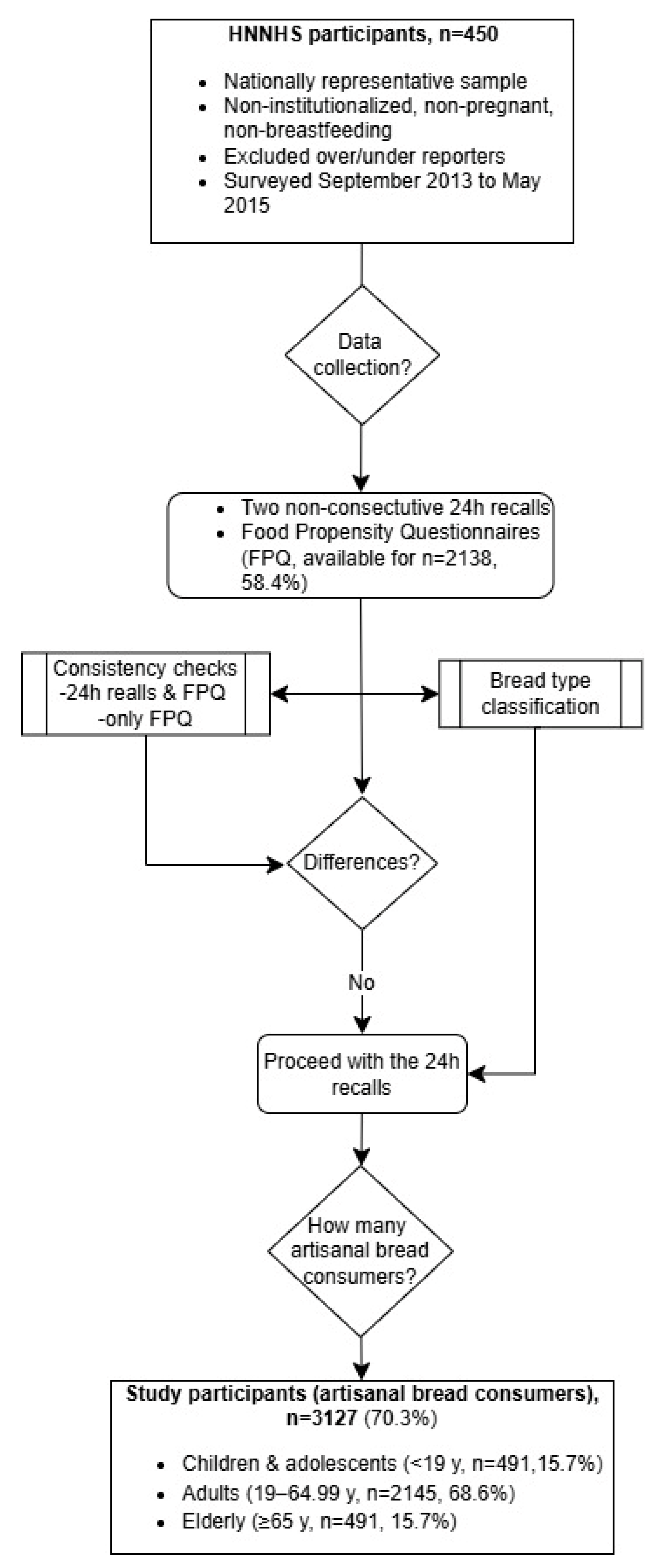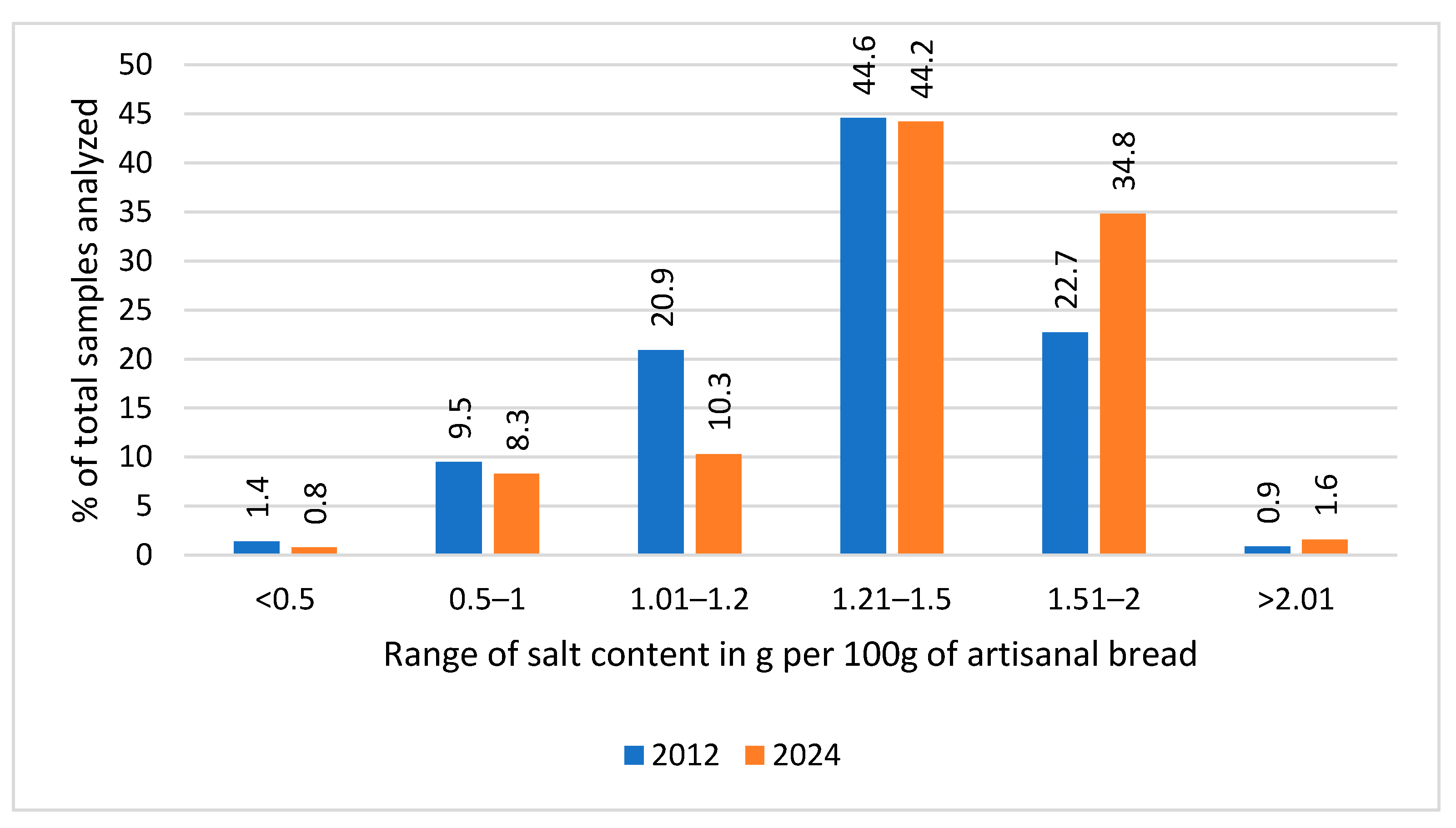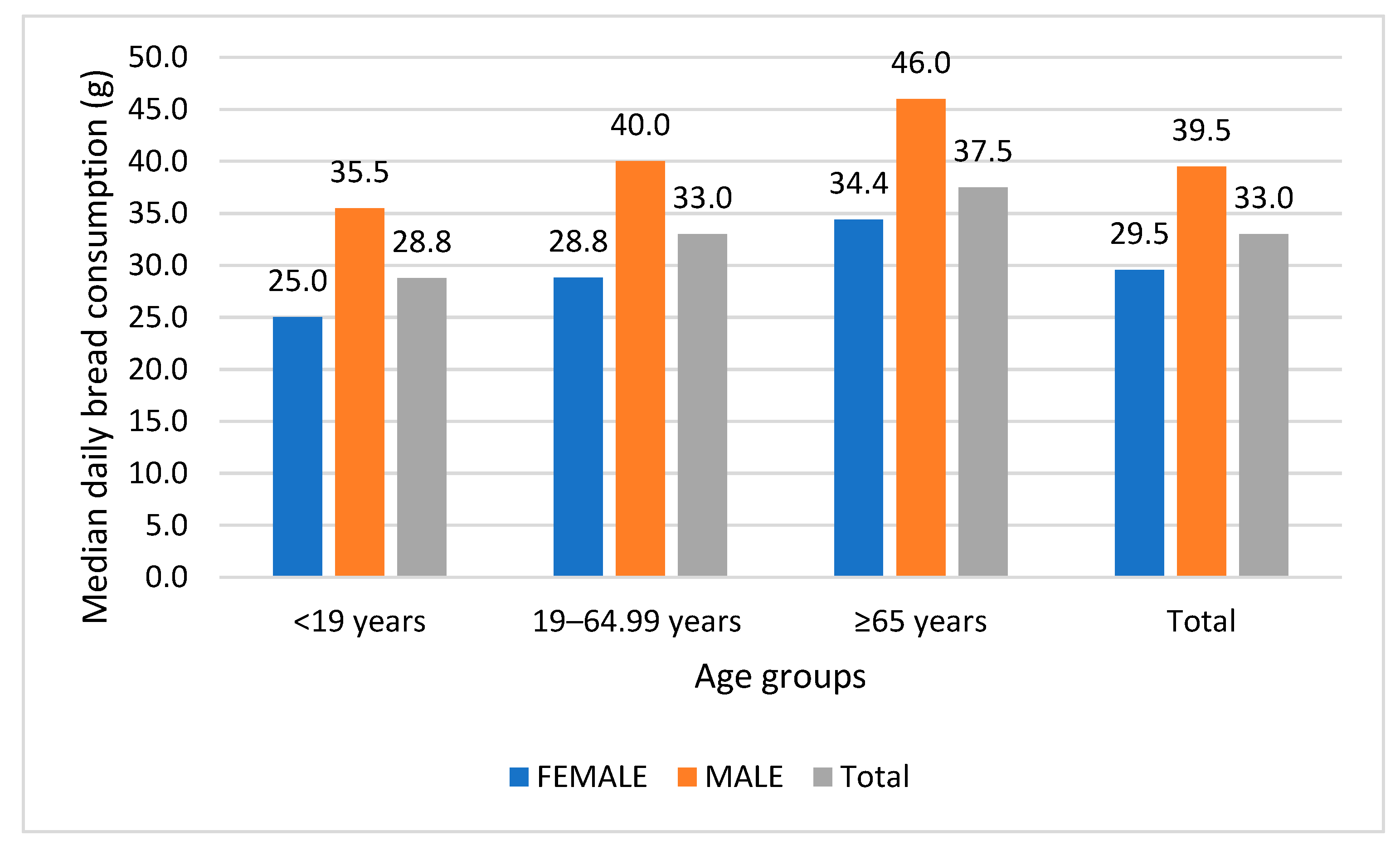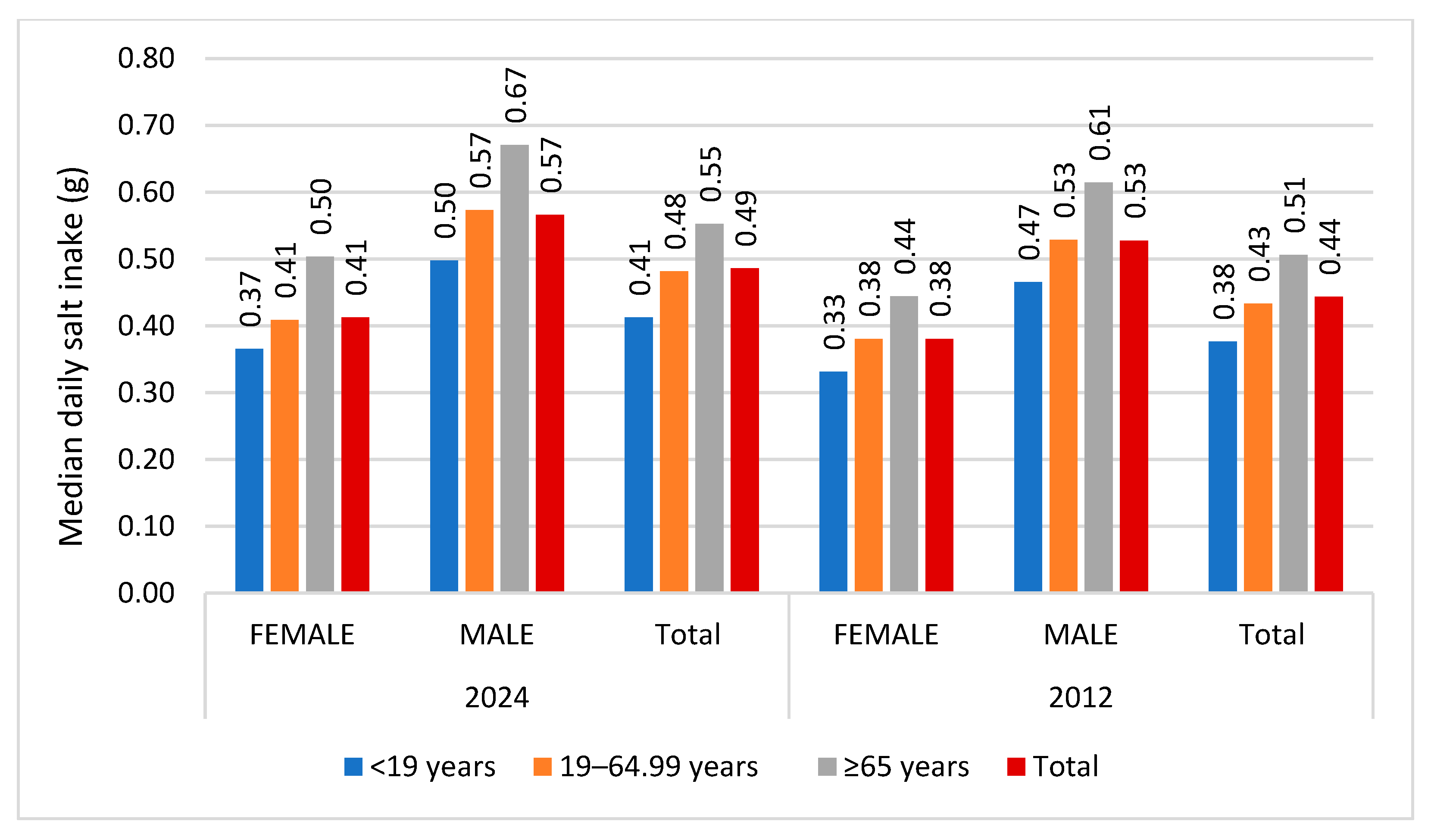Voluntary Food Reformulation Initiatives Failed to Reduce the Salt Content of Artisanal Breads in Greece
Abstract
1. Introduction
2. Methodology
2.1. Bread Sampling
2.2. Determination of Sodium Content in Bread
2.3. Hellenic National Nutrition and Health Survey Design and Study Population
2.4. Artisanal Bread Consumption Quantification
2.5. Salt Intake Quantification
2.6. Modeling Scenarios About Salt Reduction
- Counterfactual Scenario 1
- Counterfactual Scenario 2
2.7. Sensitivity Analysis
2.8. Statistical Analysis
3. Results
3.1. Salt Content Levels in Bread in 2024 to Those in 2012 (Prior to the MoU)
3.2. Bread Intake Quantification Based on HNNHS Consumption Data
3.3. Salt Intakes from Artisanal Bread Consumption in 2012 and 2024 Using Substitution Models
3.4. Modeling Salt Intake Reduction Scenarios
4. Discussion
Limitations of the Study
5. Conclusions
Supplementary Materials
Author Contributions
Funding
Institutional Review Board Statement
Informed Consent Statement
Data Availability Statement
Acknowledgments
Conflicts of Interest
References
- Afshin, A.; Sur, P.J.; Fay, K.A.; Cornaby, L.; Ferrara, G.; Salama, J.S.; Mullany, E.C.; Abate, K.H.; Abbafati, C.; Abebe, Z.; et al. Health Effects of Dietary Risks in 195 Countries, 1990–2017: A Systematic Analysis for the Global Burden of Disease Study 2017. Lancet 2019, 393, 1958–1972. [Google Scholar] [CrossRef]
- WHO. WHO Global Sodium Benchmarks for Different Food Categories; World Health Organization: Geneva, Switzerland, 2024. [Google Scholar]
- Aburto, N.J.; Ziolkovska, A.; Hooper, L.; Elliott, P.; Cappuccio, F.P.; Meerpohl, J.J. Effect of Lower Sodium Intake on Health: Systematic Review and Meta-Analyses. BMJ 2013, 346, f1326. [Google Scholar] [CrossRef]
- Yang, Q.; Vernooij, R.W.M.; Zhu, H.; Nesrallah, G.; Bai, C.; Wang, Q.; Li, Y.; Xia, D.; Bała, M.M.; Warzecha, S.; et al. Impact of Sodium Intake on Blood Pressure, Mortality and Major Cardiovascular Events: An Umbrella Review of Systematic Reviews and Meta-Analyses. Crit. Rev. Food Sci. Nutr. 2025, 65, 5903–5913. [Google Scholar] [CrossRef] [PubMed]
- Al Jawaldeh, A.; Al-Khamaiseh, M. Assessment of Salt Concentration in Bread Commonly Consumed in the Eastern Mediterranean Region. East. Mediterr. Health J. 2018, 24, 18–24. [Google Scholar] [CrossRef]
- WHO. A Global Brief on Hypertension; World Health Organization: Geneva, Switzerland, 2013. [Google Scholar]
- WHO. WHO Global Report on Sodium Intake Reduction; World Health Organization: Geneva, Switzerland, 2023. [Google Scholar]
- Hyseni, L.; Elliot-Green, A.; Lloyd-Williams, F.; Kypridemos, C.; O’Flaherty, M.; McGill, R.; Orton, L.; Bromley, H.; Cappuccio, F.P.; Capewell, S. Systematic Review of Dietary Salt Reduction Policies: Evidence for an Effectiveness Hierarchy? PLoS ONE 2017, 12, e0177535. [Google Scholar] [CrossRef]
- Marklund, M.; Trieu, K.; Aminde, L.N.; Cobiac, L.; Coyle, D.H.; Huang, L.; Neal, B.; Veerman, L.; Wu, J.H.Y. Estimated Health Effect, Cost, and Cost-Effectiveness of Mandating Sodium Benchmarks in Australia’s Packaged Foods: A Modelling Study. Lancet Public Health 2024, 9, e861–e870. [Google Scholar] [CrossRef] [PubMed]
- Trieu, K.; Huang, L.; Aminde, L.N.; Cobiac, L.; Coyle, D.H.; Wanjau, M.N.; Thout, S.R.; Neal, B.; Wu, J.H.Y.; Veerman, L.; et al. Estimated Health Benefits, Costs, and Cost-Effectiveness of Implementing WHO’s Sodium Benchmarks for Packaged Foods in India: A Modelling Study. Lancet Public Health 2024, 9, e852–e860. [Google Scholar] [CrossRef] [PubMed]
- Vasara, E.; Marakis, G.; Breda, J.; Skepastianos, P.; Hassapidou, M.; Kafatos, A.; Rodopaios, N.; Koulouri, A.; Cappuccio, F. Sodium and Potassium Intake in Healthy Adults in Thessaloniki Greater Metropolitan Area—The Salt Intake in Northern Greece (SING) Study. Nutrients 2017, 9, 417. [Google Scholar] [CrossRef]
- Marakis, G.; Marques Domingues, A.; Crispo, A.; Magriplis, E.; Vasara, E.; Kontopoulou, L.; Triantafyllou, C.; Skepastianos, P.; Papadopoulou, S.K.; Rodopaios, N.E.; et al. Pertinence of Salt-Related Knowledge and Reported Behaviour on Salt Intake in Adults: A Cross-Sectional Study. Nutrients 2023, 15, 4114. [Google Scholar] [CrossRef]
- WHO. Guideline: Sodium Intake for Adults and Children; World Health Organization: Geneva, Switzerland, 2012. [Google Scholar]
- Mitsopoulou, A.V.; Magriplis, E.; Michas, G.; Micha, R.; Chourdakis, M.; Chrousos, G.P.; Roma, E.; Panagiotakos, D.B.; Zampelas, A.; Karageorgou, D.; et al. Micronutrient Dietary Intakes and Their Food Sources in Adults: The Hellenic National Nutrition and Health Survey (HNNHS). J. Hum. Nutr. Diet. 2021, 34, 616–628. [Google Scholar] [CrossRef]
- Bouhamida, M.; Benajiba, N.; Guennoun, Y.; Lachguer, S.A.; Elhaloui, N.E.; Zahrou, F.-E.; Mounach, S.; Kari, K.E.; Al-Jawaldeh, A.; Barkat, A.; et al. Implementing the National Strategy of Salt Reduction in Morocco: The Baker’s Perspective. Pan Afr. Med. J. 2020, 37, 337. [Google Scholar] [PubMed]
- Brinsden, H.C.; He, F.J.; Jenner, K.H.; MacGregor, G.A. Surveys of the Salt Content in UK Bread: Progress Made and Further Reductions Possible. BMJ Open 2013, 3, e002936. [Google Scholar] [CrossRef]
- Centers for Disease Control and Prevention. Dietary Guidelines for Americans, 2020–2025; Centers for Disease Control and Prevention: Washington, DC, USA, 2020. [Google Scholar]
- El Ati, J.; Doggui, R.; El Ati-Hellal, M. A Successful Pilot Experiment of Salt Reduction in Tunisian Bread: 35% Gradual Decrease of Salt Content without Detection by Consumers. Int. J. Environ. Res. Public Health 2021, 18, 1590. [Google Scholar] [CrossRef]
- Woodward, E.; Eyles, H.; Ni Mhurchu, C. Key Opportunities for Sodium Reduction in New Zealand Processed Foods. Aust. N. Z. J. Public Health 2012, 36, 84–89. [Google Scholar] [CrossRef] [PubMed]
- Carcea, M.; Narducci, V.; Turfani, V.; Aguzzi, A. A Survey of Sodium Chloride Content in Italian Artisanal and Industrial Bread. Foods 2018, 7, 181. [Google Scholar] [CrossRef] [PubMed]
- Cashman, K.D.; Kenny, S.; Kerry, J.P.; Leenhardt, F.; Arendt, E.K. ‘Low-Salt’ Bread as an Important Component of a Pragmatic Reduced-Salt Diet for Lowering Blood Pressure in Adults with Elevated Blood Pressure. Nutrients 2019, 11, 1725. [Google Scholar] [CrossRef]
- Ferrante, D.; Apro, N.; Ferreira, V.; Virgolini, M.; Aguilar, V.; Sosa, M.; Perel, P.; Casas, J. Feasibility of Salt Reduction in Processed Foods in Argentina. Rev. Panam. Salud Pública 2011, 29, 69–75. [Google Scholar] [CrossRef]
- Council of the European Union. Council Conclusions of 8 June 2010 on ‘Action to Reduce Population Salt Intake for Better Health’—Adoption of the Conclusions. Available online: https://eur-lex.europa.eu/legal-content/EN/TXT/PDF/?uri=CELEX:52010XG1111(01)&from=SL (accessed on 29 September 2025).
- National Nutrition Policy Committee. Greece’s National Action Plan on Food Reformulation. Available online: https://www.moh.gov.gr/articles/health/dieythynsh-dhmosias-ygieinhs/metadotika-kai-mh-metadotika-noshmata/c388-egkyklioi/5614-efarmogh-sxedioy-drashs-gia-thn-anasynthesh-twn-proiontwn-trofimwn?fdl=15705 (accessed on 29 September 2025).
- European Association of Industrial Bakers. AIBI Bread Market Report 2012; European Association of Industrial Bakers: Brussels, Belgium, 2013. [Google Scholar]
- Nutrition Policy and Research Directorate Hellenic Food Authority Evaluation of Salt Content of Craft Breads in Greece: Implications for Public Health Nutrition. Available online: https://www.efet.gr/index.php/el/efet/home-8/symperifora-katanaloti/item/174-alati (accessed on 29 June 2025).
- ΕΝ 15505; Foodstuffs—Determination of Trace Elements—Determination of Sodium and Magnesium by Flame Atomic Absorption Spectrometry (AAS) After Microwave Digestion. European Committee for Standardization: Brussels, Belgium, 2008.
- Magriplis, E.; Dimakopoulos, I.; Karageorgou, D.; Mitsopoulou, A.-V.; Bakogianni, I.; Micha, R.; Michas, G.; Ntouroupi, T.; Tsaniklidou, S.-M.; Argyri, K.; et al. Aims, Design and Preliminary Findings of the Hellenic National Nutrition and Health Survey (HNNHS). BMC Med. Res. Methodol. 2019, 19, 37. [Google Scholar] [CrossRef]
- Karageorgou, D.; Magriplis, E.; Mitsopoulou, A.V.; Dimakopoulos, I.; Bakogianni, I.; Micha, R.; Michas, G.; Chourdakis, M.; Ntouroupi, T.; Tsaniklidou, S.M.; et al. Dietary Patterns and Lifestyle Characteristics in Adults: Results from the Hellenic National Nutrition and Health Survey (HNNHS). Public Health 2019, 171, 76–88. [Google Scholar] [CrossRef]
- Smiliotopoulos, T.; Magriplis, E.; Zampelas, A. Validation of a Food Propensity Questionnaire for the Hellenic National Nutrition and Health Survey (HNNHS) and Results on This Population’s Adherence to Key Food-Group Nutritional Guidelines. Nutrients 2020, 12, 1808. [Google Scholar] [CrossRef]
- National Dietary Guidelines. Available online: http://diatrofikoiodigoi.gr/?Page=english-menu (accessed on 26 June 2025).
- Kugler, S.; Hristov, H.; Blaznik, U.; Hribar, M.; Hafner, E.; Kušar, A.; Pravst, I. Insights into the Salt Levels in Bread Offers in Slovenia: Trends and Differences. Front. Nutr. 2025, 11, 1473362. [Google Scholar] [CrossRef]
- Temme, E.; Hendriksen, M.; Milder, I.; Toxopeus, I.; Westenbrink, S.; Brants, H.; Van Der A, D.L. Salt Reductions in Some Foods in The Netherlands: Monitoring of Food Composition and Salt Intake. Nutrients 2017, 9, 791. [Google Scholar] [CrossRef]
- Hellenic Statistical Authority. Household Budget Survey, 2023; Hellenic Statistical Authority: Piraeus, Greece, 2023. [Google Scholar]
- Hellenic Statistical Authority. Household Budget Survey (HBS), 2013; Hellenic Statistical Authority: Piraeus, Greece, 2013. [Google Scholar]
- Kuhar, A.; Korošec, M.; Bolha, A.; Pravst, I.; Hristov, H. Is a Consumer Perception of Salt Modification a Sensory or a Behavioural Phenomenon? Insights from a Bread Study. Foods 2020, 9, 1172. [Google Scholar] [CrossRef] [PubMed]
- Saavedra-Garcia, L.; Sosa-Zevallos, V.; Diez-Canseco, F.; Miranda, J.J.; Bernabe-Ortiz, A. Reducing Salt in Bread: A Quasi-Experimental Feasibility Study in a Bakery in Lima, Peru. Public Health Nutr. 2016, 19, 976–982. [Google Scholar] [CrossRef]
- Lobo, C.P.; Ferreira, T.A.P.D.C. Hedonic Thresholds and Ideal Sodium Content Reduction of Bread Loaves. Food Res. Int. 2021, 140, 110090. [Google Scholar] [CrossRef]
- Marakis, G.; Tsigarida, E.; Mila, S.; Panagiotakos, D.B. Knowledge, Attitudes and Behaviour of Greek Adults towards Salt Consumption: A Hellenic Food Authority Project. Public Health Nutr. 2014, 17, 1877–1893. [Google Scholar] [CrossRef] [PubMed]
- Webster, J.; Trieu, K.; Dunford, E.; Hawkes, C. Target Salt 2025: A Global Overview of National Programs to Encourage the Food Industry to Reduce Salt in Foods. Nutrients 2014, 6, 3274–3287. [Google Scholar] [CrossRef]
- Loloei, S.; Pouraram, H.; Majdzadeh, R.; Takian, A.; Goshtaei, M.; Djazayery, A. Policy Analysis of Salt Reduction in Bread in Iran. AIMS Public Health 2019, 6, 534–545. [Google Scholar] [CrossRef] [PubMed]
- Grabež, M.; Grujic, V.R.; Ahmetovic, N.; Novaković, B. Sodium Content and the Most Important Dietary Sources of Sodium in a Sample of Student Population. J. Hyg. Eng. Des. 2017, 44–48. [Google Scholar]
- Lazić, V. Salt Content in White Bread in the Republic of Srpska. Scr. Medica 2017, 48, 24–29. [Google Scholar] [CrossRef]
- Martini, D.; Strazzullo, P.; Serafini, M.; Porrini, M.; Pellegrini, N.; Angelino, D. Sodium Content in Cereal-Based Products Sold in Italy: How Far Are We from the Global Benchmarks? Nutrients 2022, 14, 3088. [Google Scholar] [CrossRef]
- Jessen, N.; Damasceno, A.; Padrão, P.; Lunet, N. Levels of Salt Reduction in Bread, Acceptability and Purchase Intention by Urban Mozambican Consumers. Foods 2022, 11, 454. [Google Scholar] [CrossRef]
- GCSL Food and Drink Code. Available online: https://www.aade.gr/sites/default/files/2020-03/111-iss2.pdf (accessed on 25 June 2025).
- Dunteman, A.N.; Lee, S. Consumer Acceptance of Reduced Sodium White and Multigrain Bread: Impact of Flavor Enhancement and Ingredient Information on Sample Liking. J. Food Sci. 2023, 88, 417–429. [Google Scholar] [CrossRef]
- Girgis, S.; Neal, B.; Prescott, J.; Prendergast, J.; Dumbrell, S.; Turner, C.; Woodward, M. A One-Quarter Reduction in the Salt Content of Bread Can Be Made without Detection. Eur. J. Clin. Nutr. 2003, 57, 616–620. [Google Scholar] [CrossRef]
- Pasqualone, A.; Caponio, F.; Pagani, M.A.; Summo, C.; Paradiso, V.M. Effect of Salt Reduction on Quality and Acceptability of Durum Wheat Bread. Food Chem. 2019, 289, 575–581. [Google Scholar] [CrossRef]
- Lynch, E.J.; Dal Bello, F.; Sheehan, E.M.; Cashman, K.D.; Arendt, E.K. Fundamental Studies on the Reduction of Salt on Dough and Bread Characteristics. Food Res. Int. 2009, 42, 885–891. [Google Scholar] [CrossRef]
- Belz, M.C.E.; Ryan, L.A.M.; Arendt, E.K. The Impact of Salt Reduction in Bread: A Review. Crit. Rev. Food Sci. Nutr. 2012, 52, 514–524. [Google Scholar] [CrossRef]
- Bolhuis, D.P.; Temme, E.H.M.; Koeman, F.T.; Noort, M.W.J.; Kremer, S.; Janssen, A.M. A Salt Reduction of 50% in Bread Does Not Decrease Bread Consumption or Increase Sodium Intake by the Choice of Sandwich Fillings. J. Nutr. 2011, 141, 2249–2255. [Google Scholar] [CrossRef]
- Jaenke, R.; Barzi, F.; McMahon, E.; Webster, J.; Brimblecombe, J. Consumer Acceptance of Reformulated Food Products: A Systematic Review and Meta-Analysis of Salt-Reduced Foods. Crit. Rev. Food Sci. Nutr. 2017, 57, 3357–3372. [Google Scholar] [CrossRef] [PubMed]
- La Croix, K.W.; Fiala, S.C.; Colonna, A.E.; Durham, C.A.; Morrissey, M.T.; Drum, D.K.; Kohn, M.A. Consumer Detection and Acceptability of Reduced-Sodium Bread. Public Health Nutr. 2015, 18, 1412–1418. [Google Scholar] [CrossRef] [PubMed]
- Hellenic Statistical Authority Demographic Characteristics/2021. Available online: https://www.statistics.gr/en/statistics/-/publication/SAM03/- (accessed on 1 July 2025).
- Tan, M. Mandatory Salt Targets: A Key Policy Tool for Global Salt Reduction Efforts. Lancet Public Health 2024, 9, e834–e835. [Google Scholar] [CrossRef] [PubMed]
- House of Lords. Recipe for Health: A Plan to Fix Our Broken Food System; House of Lords: London, UK, 2024. [Google Scholar]
- Santos, J.A.; Tekle, D.; Rosewarne, E.; Flexner, N.; Cobb, L.; Al-Jawaldeh, A.; Kim, W.J.; Breda, J.; Whiting, S.; Campbell, N.; et al. A Systematic Review of Salt Reduction Initiatives Around the World: A Midterm Evaluation of Progress Towards the 2025 Global Non-Communicable Diseases Salt Reduction Target. Adv. Nutr. 2021, 12, 1768–1780. [Google Scholar] [CrossRef] [PubMed]
- Goiana-da-Silva, F.; Cruz-e-Silva, D.; Rito, A.; Lopes, C.; Muc, M.; Darzi, A.; Araújo, F.; Miraldo, M.; Morais Nunes, A.; Allen, L.N. Modeling the Health Impact of Legislation to Limit the Salt Content of Bread in Portugal: A Macro Simulation Study. Front. Public Health 2022, 10, 876827. [Google Scholar] [CrossRef] [PubMed]




| Βread Type | Sampling 2012 1 | Sampling 2024 | Percent Change in Mean 2 | ||
|---|---|---|---|---|---|
| n = 220 | Mean (sd) (g/100 g) | n = 253 | Mean (sd) (g/100 g) | ||
| White | 140 | 1.37 (0.24) | 139 | 1.45 (0.23) | 5.8 |
| Brown | 80 | 1.25 (0.36) | 114 | 1.36 (0.36) | 8.1 |
| Scenario | Median (p25, p75) Daily Salt Intake (g) from Artisanal Bread Only | Median (p25, p75) Daily Total Salt Intake (g) from All Foods | Consumers Exceeding WHO Salt Intake Threshold-Exceeders (n) | Percentage of Exceeders over Bread Consumers (n = 3127) | Percent Reduction in Exceeders Among Bread Consumers Overall (%) | Percent Reduction in Exceeders Relative to Baseline Exceeders (%) |
|---|---|---|---|---|---|---|
| Baseline analysis | 0.49 (0.27, 0.80) | 5.31 (3.69, 7.49) | 1724 | 55.13 | ||
| Counterfactual scenario 1 All products ≤ 1.2 g/100 g bread | 0.39 (0.22, 0.65) | 5.18 (3.58, 7.36) | 1669 | 53.37 | 1.7 | 3.2 |
| Counterfactual scenario 2 All products ≤ 0.925 g/100 g bread (WHO benchmark) | 0.31 (0.18, 0.50) | 5.09 (3.49, 7.22) | 1616 | 51.68 | 3.4 | 6.3 |
Disclaimer/Publisher’s Note: The statements, opinions and data contained in all publications are solely those of the individual author(s) and contributor(s) and not of MDPI and/or the editor(s). MDPI and/or the editor(s) disclaim responsibility for any injury to people or property resulting from any ideas, methods, instructions or products referred to in the content. |
© 2025 by the authors. Licensee MDPI, Basel, Switzerland. This article is an open access article distributed under the terms and conditions of the Creative Commons Attribution (CC BY) license (https://creativecommons.org/licenses/by/4.0/).
Share and Cite
Marakis, G.; Kotopoulou, S.; Skoulika, S.; Petropoulos, G.; Mousia, Z.; Magriplis, E.; Zampelas, A. Voluntary Food Reformulation Initiatives Failed to Reduce the Salt Content of Artisanal Breads in Greece. Nutrients 2025, 17, 3374. https://doi.org/10.3390/nu17213374
Marakis G, Kotopoulou S, Skoulika S, Petropoulos G, Mousia Z, Magriplis E, Zampelas A. Voluntary Food Reformulation Initiatives Failed to Reduce the Salt Content of Artisanal Breads in Greece. Nutrients. 2025; 17(21):3374. https://doi.org/10.3390/nu17213374
Chicago/Turabian StyleMarakis, Georgios, Sotiria Kotopoulou, Stavroula Skoulika, Georgios Petropoulos, Zoe Mousia, Emmanuella Magriplis, and Antonis Zampelas. 2025. "Voluntary Food Reformulation Initiatives Failed to Reduce the Salt Content of Artisanal Breads in Greece" Nutrients 17, no. 21: 3374. https://doi.org/10.3390/nu17213374
APA StyleMarakis, G., Kotopoulou, S., Skoulika, S., Petropoulos, G., Mousia, Z., Magriplis, E., & Zampelas, A. (2025). Voluntary Food Reformulation Initiatives Failed to Reduce the Salt Content of Artisanal Breads in Greece. Nutrients, 17(21), 3374. https://doi.org/10.3390/nu17213374









